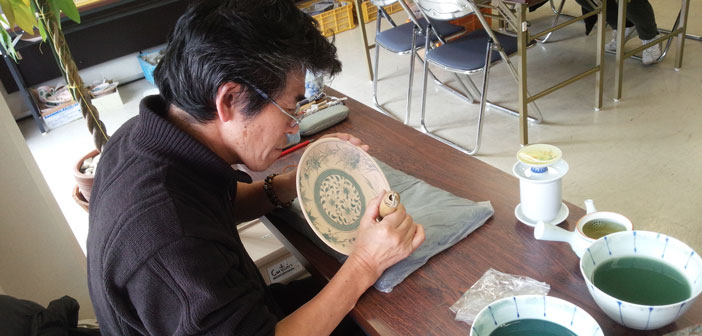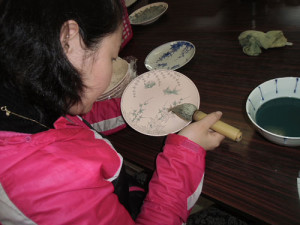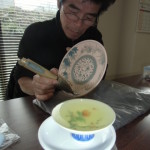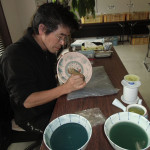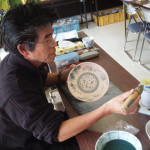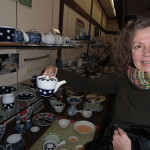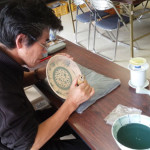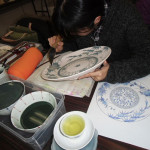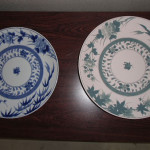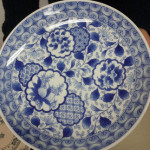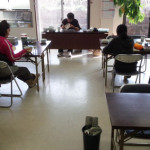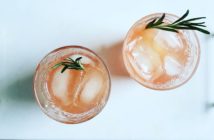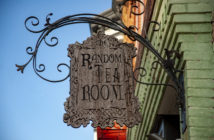A cup of tea is a painting tool for some traditional potters in the tea growing region of Ureshino, Japan. For these talented artists, tea is much more than a satisfying drink. They mix tea with paint to produce works of art that are renowned throughout Japan.
Master potter Tatsuo Ichikawa is one such artist. While researching tea culture at a potters’ cooperative in Ureshino, I was invited to watch him teach his art to other professional potters. The classroom was quiet. Ichikawa leads his pupils by example instead of theory or explanation. As I entered, they smiled and resumed focusing on their artwork. The only movements in the pottery room were brushes stroking pottery, leaving tiny trails of beautiful blue-toned designs on beige porcelain.
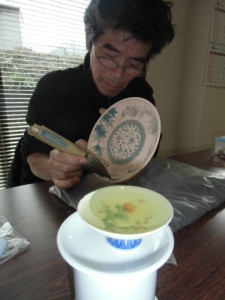 The master potter deftly held a wooden paint brush. The belly of the brush was as wide as a small onion, but it tapered to a hair-thin point. He painted intricate patterns with smooth and sure motions that emerge only after decades of practice. A small, clear cup of light green tea was within arm’s reach. Each student also had a cup of tea nearby. The master seemed to be reaching for his tea, but instead of drinking from it, he dipped the black hairs of his brush into the tea. Without seeming to realize his mistake, he continued painting the dish. From the corner of my eye, I saw a student do the same. Then one more student followed suit.
The master potter deftly held a wooden paint brush. The belly of the brush was as wide as a small onion, but it tapered to a hair-thin point. He painted intricate patterns with smooth and sure motions that emerge only after decades of practice. A small, clear cup of light green tea was within arm’s reach. Each student also had a cup of tea nearby. The master seemed to be reaching for his tea, but instead of drinking from it, he dipped the black hairs of his brush into the tea. Without seeming to realize his mistake, he continued painting the dish. From the corner of my eye, I saw a student do the same. Then one more student followed suit.
After the class finished, the master spoke about painting with tea. Tea is a natural pigment that can create fine transitions in the colors of pottery designs. These subtle variations of colors would not exist if water were used as a thinning agent. The tea-paint combination works especially well with shading and outlining. The best tea for decorating pottery is actually cheap, weak tea. High quality tea tends to contain too much powder.
Creating the visual effect known as gradation, which means the smooth flow from one color hue to another hue, or one texture to another texture, takes high-level skills and requires considerable time. Depending on the size of a tea cup, he might spend between half a day and an entire day to paint the cup.
Manufacturers of mass produced porcelain do not use tea. Tea is used only by master artists who hand paint designs. Mixing tea with paint is an indigenous technique that has been passed down across generations of potters. The identity of the first artist to incorporate tea with paint is a mystery. The custom may go back four hundred years to the beginning of pottery making in the neighboring town of Arita.
Ichikawa vigorously promotes this porcelain painting tradition to potters from across Japan, who flock to Arita and Ureshino to learn how to create the local fashion of pottery called aritayaki. Arita style plates, sake cups, teapots and tea cups are in great demand throughout the country.
Unfortunately, appreciation of fine craftsmanship is decreasing in Japan. Japan is flooded by mass-produced Chinese pottery that is sold in the Japanese equivalent of American dollar stores. In an effort to promote an awareness and understanding of local arts and traditional crafts, the Saga Prefecture requested Ichikawa to lead pottery workshops for children and their parents.
Ichikawa is leading a movement to revitalize an appreciation of traditional Japanese art within twenty-first-century lifestyles. If you’d like to take a tea tour of Japan and support artists such as Ichikawa, Ureshino’s Yoshidayaki Kamamoto Kaikan’s pottery cooperative is definitely worth visiting.
View more of Ichikawa’s art.

